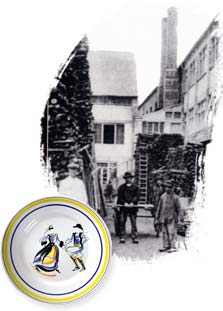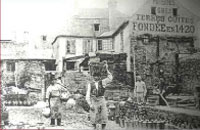|
 Quimper is the ancient capital of La Cornouaille, Brittany’s most traditional region, and has a distinctive Breton character. Shops and flags celebrating the region's Celtic heritage can be found throughout the city. Quimper was originally settled during Roman times. By AD 495, the town had become a Bishopric. It subsequently became the capital of the counts of Cornouailles. In the 11th century, it was united with the Duchy of Brittany. During the civil wars of the 14th century, the town suffered considerable ruin. In 1364, the duchy passed to the House of Montfort. Quimper is the ancient capital of La Cornouaille, Brittany’s most traditional region, and has a distinctive Breton character. Shops and flags celebrating the region's Celtic heritage can be found throughout the city. Quimper was originally settled during Roman times. By AD 495, the town had become a Bishopric. It subsequently became the capital of the counts of Cornouailles. In the 11th century, it was united with the Duchy of Brittany. During the civil wars of the 14th century, the town suffered considerable ruin. In 1364, the duchy passed to the House of Montfort.
The town has a rustic atmosphere with footbridges spanning the rivers that flow through it. The Church of Locmaria, a Romanesque structure, dates from the eleventh century. The Cathedral of Saint-Corentin, with its Gothic-style façade, was constructed between the 13th and 16th centuries. It is the oldest Gothic structure in lower Brittany. Its two towers are 250 feet tall; its spires were added in the 19th century. The 15th century stained glass windows are exceptional. The cathedral is dedicated to Quimper's first bishop, Corentin.
Saint Corentin (Corentinus; in Breton, Sant Kaourintin) (d. 460 AD) is a Breton saint. He is venerated as a saint and as the first bishop of Quimper. His feast day is December 12. He was a hermit at Plomodiern and regarded as one of the seven founder saints of Brittany. Corentin is the patron saint of Cornouaille, Brittany, and also the patron saint of seafood.
 To the cathedral's west are the pedestrianized streets of Vieux Quimper with a wide array of crêperies, half-timbered houses and shops. Near the Episcopal palace, which now holds the Musée départemental Breton (devoted to regional history, archaeology, ethnology and economy) are the ruins of the town's 15th century walls. Nearby is the Musée des Beaux-Arts. The museum has a nineteenth century façade and an entirely rebuilt interior. It houses a collection of 14th to 21st century paintings that includes works by Boucher, Corot, Oudry and Rubens along with canvases by such Pont-Aven School painters as Bernard, Denis, Lacombe, Maufra and Paul Sérusier. To the cathedral's west are the pedestrianized streets of Vieux Quimper with a wide array of crêperies, half-timbered houses and shops. Near the Episcopal palace, which now holds the Musée départemental Breton (devoted to regional history, archaeology, ethnology and economy) are the ruins of the town's 15th century walls. Nearby is the Musée des Beaux-Arts. The museum has a nineteenth century façade and an entirely rebuilt interior. It houses a collection of 14th to 21st century paintings that includes works by Boucher, Corot, Oudry and Rubens along with canvases by such Pont-Aven School painters as Bernard, Denis, Lacombe, Maufra and Paul Sérusier.
The town's best known product is Quimper faïence pottery. It has been made here since 1690, using bold provincial designs of Jean-Baptiste Bousquet. The town’s eating establishments boast some of the best crêpes and cider in Brittany. The town has also been known for copper and bronze work, food items, galvanized ironware, hosiery, leather, paper and woollen goods.
Courtesy of Wikipedia
|

